Дипломная работа: Triple-wave ensembles in a thin cylindrical shell
Раздел: Рефераты по математике
Тип: дипломная работа
TRIPLE-WAVE ENSEMBLES IN A THIN CYLINDRICAL SHELL
Kovriguine DA, Potapov AI
Introduction
Primitive nonlinear quasi-harmonic triple-wave patterns in a thin-walled cylindrical shell are investigated. This task is focused on the resonant properties of the system. The main idea is to trace the propagation of a quasi-harmonic signal — is the wave stable or not? The stability prediction is based on the iterative mathematical procedures. First, the lowest-order nonlinear approximation model is derived and tested. If the wave is unstable against small perturbations within this approximation, then the corresponding instability mechanism is fixed and classified. Otherwise, the higher-order iterations are continued up to obtaining some definite result.
The theory of thin-walled shells based on the Kirhhoff-Love hypotheses is used to obtain equations governing nonlinear oscillations in a shell. Then these equations are reduced to simplified mathematical models in the form of modulation equations describing nonlinear coupling between quasi-harmonic modes. Physically, the propagation velocity of any mechanical signal should not exceed the characteristic wave velocity inherent in the material of the plate. This restriction allows one to define three main types of elemental resonant ensembles — the triads of quasi-harmonic modes of the following kinds:
(i)
high-frequency longitudinal and two
low-frequency bending waves (![]() -type
triads);
-type
triads);
(ii)high-frequency
shear and two low-frequency bending waves (![]() );
);
(iii)high-frequency
bending, low-frequency bending and shear waves (![]() );
);
(iv)high-frequency
bending and two low-frequency bending waves (![]() ).
).
Here subscripts identify the type of modes, namely (![]() ) — longitudinal, (
) — longitudinal, (![]() ) — bending, and (
) — bending, and (![]() ) — shear mode. The first
one stands for the primary unstable high-frequency mode, the other two
subscripts denote secondary low-frequency modes.
) — shear mode. The first
one stands for the primary unstable high-frequency mode, the other two
subscripts denote secondary low-frequency modes.
Triads of the first three kinds (i — iii) can be
observed in a flat plate (as the curvature of the shell goes to zero), while
the ![]() -type triads are inherent
in cylindrical shells only.
-type triads are inherent
in cylindrical shells only.
Notice that the known Karman-type dynamical
governing equations can describe the ![]() -type
triple-wave coupling only. The other triple-wave resonant ensembles,
-type
triple-wave coupling only. The other triple-wave resonant ensembles, ![]() ,
, ![]() and
and ![]() , which refer to the
nonlinear coupling between high-frequency shear (longitudinal) mode and
low-frequency bending modes, cannot be described by this model.
, which refer to the
nonlinear coupling between high-frequency shear (longitudinal) mode and
low-frequency bending modes, cannot be described by this model.
Quasi-harmonic bending waves, whose group velocities do not exceed the typical propagation velocity of shear waves, are stable against small perturbations within the lowest-order nonlinear approximation analysis. However amplitude envelopes of these waves can be unstable with respect to small long-wave perturbations in the next approximation. Generally, such instability is associated with the degenerated four-wave resonant interactions. In the present paper the second-order approximation effects is reduced to consideration of the self-action phenomenon only. The corresponding mathematical model in the form of Zakharov-type equations is proposed to describe such high-order nonlinear wave patterns.
Governing equations
We consider a deformed state of a thin-walled
cylindrical shell of the length ![]() ,
thickness
,
thickness ![]() , radius
, radius ![]() , in the frame of
references
, in the frame of
references ![]() . The
. The ![]() -coordinate belongs to a
line beginning at the center of curvature, and passing perpendicularly to the
median surface of the shell, while
-coordinate belongs to a
line beginning at the center of curvature, and passing perpendicularly to the
median surface of the shell, while ![]() and
and ![]() are in-plane coordinates
on this surface (
are in-plane coordinates
on this surface (![]() ). Since the
cylindrical shell is an axisymmetric elastic structure, it is convenient to
pass from the actual frame of references to the cylindrical coordinates, i.e.
). Since the
cylindrical shell is an axisymmetric elastic structure, it is convenient to
pass from the actual frame of references to the cylindrical coordinates, i.e. ![]() , where
, where ![]() and
and ![]() . Let the vector of
displacements of a material point lying on the median surface be
. Let the vector of
displacements of a material point lying on the median surface be ![]() . Here
. Here ![]() ,
, ![]() and
and ![]() stand for the
longitudinal, circumferential and transversal components of displacements along
the coordinates
stand for the
longitudinal, circumferential and transversal components of displacements along
the coordinates ![]() and
and ![]() , respectively, at the time
, respectively, at the time
![]() . Then the spatial
distribution of displacements reads
. Then the spatial
distribution of displacements reads
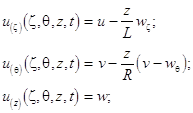
accordingly to the geometrical paradigm of the
Kirhhoff-Love hypotheses. From the viewpoint of further mathematical
rearrangements it is convenient to pass from the physical sought variables ![]() to the corresponding
dimensionless displacements
to the corresponding
dimensionless displacements ![]() . Let
the radius and the length of the shell be comparable values, i.e.
. Let
the radius and the length of the shell be comparable values, i.e. ![]() , while the displacements
be small enough, i.e.
, while the displacements
be small enough, i.e. ![]() . Then the
components of the deformation tensor can be written in the form
. Then the
components of the deformation tensor can be written in the form
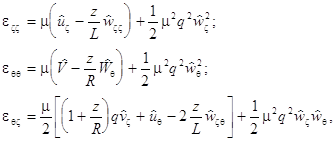
where ![]() is the
small parameter;
is the
small parameter; ![]() ;
; ![]() and
and ![]() . The expression for the
spatial density of the potential energy of the shell can be obtained using
standard stress-straight relationships accordingly to the dynamical part of the
Kirhhoff-Love hypotheses:
. The expression for the
spatial density of the potential energy of the shell can be obtained using
standard stress-straight relationships accordingly to the dynamical part of the
Kirhhoff-Love hypotheses:
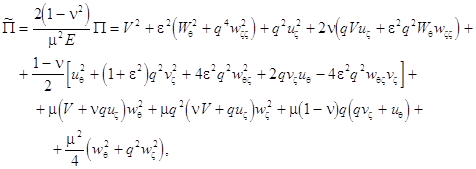
where ![]() is the
Young modulus;
is the
Young modulus; ![]() denotes the
Poisson ratio;
denotes the
Poisson ratio; ![]() (the primes
indicating the dimensionless variables have been omitted). Neglecting the
cross-section inertia of the shell, the density of kinetic energy reads
(the primes
indicating the dimensionless variables have been omitted). Neglecting the
cross-section inertia of the shell, the density of kinetic energy reads

where ![]() is the
dimensionless time;
is the
dimensionless time; ![]() is typical
propagation velocity.
is typical
propagation velocity.
Let the Lagrangian of the system be ![]() .
.
By using the variational procedures of mechanics, one can obtain the following equations governing the nonlinear vibrations of the cylindrical shell (the Donnell model):
(1)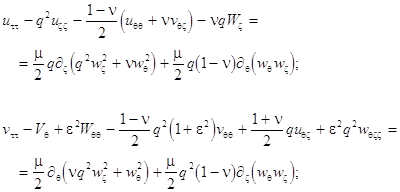
(2)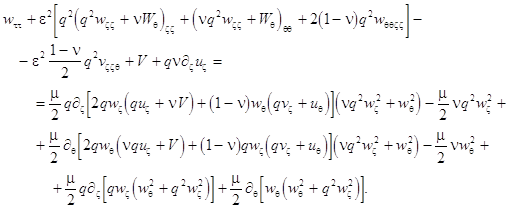
Equations (1) and (2) are supplemented by the periodicity conditions
![]()
Dispersion of linear waves
At ![]() the
linear subset of eqs.(1)-(2) describes a superposition of harmonic waves
the
linear subset of eqs.(1)-(2) describes a superposition of harmonic waves
(3)![]()
Here ![]() is the
vector of complex-valued wave amplitudes of the longitudinal, circumferential
and bending component, respectively;
is the
vector of complex-valued wave amplitudes of the longitudinal, circumferential
and bending component, respectively; ![]() is the
phase, where
is the
phase, where ![]() are the natural
frequencies depending upon two integer numbers, namely
are the natural
frequencies depending upon two integer numbers, namely ![]() (number of half-waves in
the longitudinal direction) and
(number of half-waves in
the longitudinal direction) and ![]() (number
of waves in the circumferential direction). The dispersion relation defining
this dependence
(number
of waves in the circumferential direction). The dispersion relation defining
this dependence ![]() has the form
has the form
(4)
where
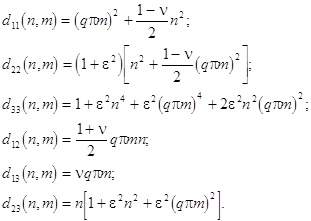
In the general case this equation possesses three
different roots (![]() ) at fixed values
of
) at fixed values
of ![]() and
and ![]() . Graphically, these
solutions are represented by a set of points occupied the three surfaces
. Graphically, these
solutions are represented by a set of points occupied the three surfaces ![]() . Their intersections with
a plane passing the axis of frequencies are given by fig.(1). Any natural
frequency
. Their intersections with
a plane passing the axis of frequencies are given by fig.(1). Any natural
frequency ![]() corresponds to the
three-dimensional vector of amplitudes
corresponds to the
three-dimensional vector of amplitudes ![]() .
The components of this vector should be proportional values, e.g.
.
The components of this vector should be proportional values, e.g. ![]() , where the ratios
, where the ratios

and

are obeyed to the orthogonality conditions
![]()
as ![]()
![]() .
.
Assume that ![]() ,
then the linearized subset of eqs.(1)-(2) describes planar oscillations in a
thin ring. The low-frequency branch corresponding generally to bending waves is
approximated by
,
then the linearized subset of eqs.(1)-(2) describes planar oscillations in a
thin ring. The low-frequency branch corresponding generally to bending waves is
approximated by ![]() and
and ![]() , while the high-frequency
azimuthal branch —
, while the high-frequency
azimuthal branch — ![]() and
and ![]() . The bending and azimuthal
modes are uncoupled with the shear modes. The shear modes are polarized in the
longitudinal direction and characterized by the exact dispersion relation
. The bending and azimuthal
modes are uncoupled with the shear modes. The shear modes are polarized in the
longitudinal direction and characterized by the exact dispersion relation ![]() .
.
Consider now axisymmetric waves (as ![]() ). The axisymmetric shear
waves are polarized by azimuth:
). The axisymmetric shear
waves are polarized by azimuth: ![]() , while
the other two modes are uncoupled with the shear mode. These high- and
low-frequency branches are defined by the following biquadratic equation
, while
the other two modes are uncoupled with the shear mode. These high- and
low-frequency branches are defined by the following biquadratic equation
![]() .
.
At the vicinity of ![]() the
high-frequency branch is approximated by
the
high-frequency branch is approximated by
![]() ,
,
while the low-frequency branch is given by
![]() .
.
Let ![]() , then
the high-frequency asymptotic be
, then
the high-frequency asymptotic be
![]() ,
,
while the low-frequency asymptotic:
![]() .
.
When neglecting the in-plane inertia of elastic waves, the governing equations (1)-(2) can be reduced to the following set (the Karman model):
(5)
Here ![]() and
and ![]() are the differential
operators;
are the differential
operators; ![]() denotes the Airy stress
function defined by the relations
denotes the Airy stress
function defined by the relations ![]() ,
, ![]() and
and ![]() , where
, where ![]() , while
, while ![]() ,
, ![]() and
and ![]() stand for the components
of the stress tensor. The linearized subset of eqs.(5), at
stand for the components
of the stress tensor. The linearized subset of eqs.(5), at ![]() , is represented by a
single equation
, is represented by a
single equation
![]()
defining a single variable ![]() , whose solutions satisfy
the following dispersion relation
, whose solutions satisfy
the following dispersion relation
(6)
Notice that the expression (6) is a good approximation of the low-frequency branch defined by (4).
Evolution equations
If ![]() , then
the ansatz (3) to the eqs.(1)-(2) can lead at large times and spatial
distances,
, then
the ansatz (3) to the eqs.(1)-(2) can lead at large times and spatial
distances, ![]() , to a lack of the same
order that the linearized solutions are themselves. To compensate this defect,
let us suppose that the amplitudes
, to a lack of the same
order that the linearized solutions are themselves. To compensate this defect,
let us suppose that the amplitudes ![]() be now
the slowly varying functions of independent coordinates
be now
the slowly varying functions of independent coordinates ![]() ,
, ![]() and
and ![]() , although the ansatz to
the nonlinear governing equations conserves formally the same form (3):
, although the ansatz to
the nonlinear governing equations conserves formally the same form (3):
![]()
Obviously, both the slow ![]() and
the fast
and
the fast ![]() spatio-temporal scales
appear in the problem. The structure of the fast scales is fixed by the fast
rotating phases (
spatio-temporal scales
appear in the problem. The structure of the fast scales is fixed by the fast
rotating phases (![]() ), while the
dependence of amplitudes
), while the
dependence of amplitudes ![]() upon
the slow variables is unknown.
upon
the slow variables is unknown.
This dependence is defined by the evolution equations describing the slow spatio-temporal modulation of complex amplitudes.
There are many routs to obtain the evolution
equations. Let us consider a technique based on the Lagrangian variational
procedure. We pass from the density of Lagrangian function ![]() to its average value
to its average value
(7) ,
,
An advantage of the transform (7) is that the
average Lagrangian depends only upon the slowly varying complex amplitudes and
their derivatives on the slow spatio-temporal scales ![]() ,
, ![]() and
and ![]() . In turn, the average
Lagrangian does not depend upon the fast variables.
. In turn, the average
Lagrangian does not depend upon the fast variables.
The average Lagrangian ![]() can
be formally represented as power series in
can
be formally represented as power series in ![]() :
:
(8)![]()
At ![]() the
average Lagrangian (8) reads
the
average Lagrangian (8) reads
![]()
where the coefficient ![]() coincides
exactly with the dispersion relation (3). This means that
coincides
exactly with the dispersion relation (3). This means that ![]() .
.
The first-order approximation average Lagrangian ![]() depends upon the slowly
varying complex amplitudes and their first derivatives on the slow
spatio-temporal scales
depends upon the slowly
varying complex amplitudes and their first derivatives on the slow
spatio-temporal scales ![]() ,
, ![]() and
and ![]() . The corresponding
evolution equations have the following form
. The corresponding
evolution equations have the following form
(9)
Notice that the second-order approximation evolution
equations cannot be directly obtained using the formal expansion of the average
Lagrangian ![]() , since some corrections of
the term
, since some corrections of
the term ![]() are necessary. These
corrections are resulted from unknown additional terms
are necessary. These
corrections are resulted from unknown additional terms ![]() of order
of order ![]() , which should generalize
the ansatz (3):
, which should generalize
the ansatz (3):
![]()
provided that the second-order approximation nonlinear effects are of interest.
Triple-wave resonant ensembles
The lowest-order nonlinear analysis predicts that eqs.(9) should describe the evolution of resonant triads in the cylindrical shell, provided the following phase matching conditions
(10)![]() ,
,
hold true, plus the nonlinearity in eqs.(1)-(2)
possesses some appropriate structure. Here ![]() is
a small phase detuning of order
is
a small phase detuning of order ![]() , i.e.
, i.e. ![]() . The phase matching
conditions (10) can be rewritten in the alternative form
. The phase matching
conditions (10) can be rewritten in the alternative form

where ![]() is a
small frequency detuning;
is a
small frequency detuning; ![]() and
and ![]() are the wave numbers of
three resonantly coupled quasi-harmonic nonlinear waves in the circumferential
and longitudinal directions, respectively. Then the evolution equations (9) can
be reduced to the form analogous to the classical Euler equations, describing
the motion of a gyro:
are the wave numbers of
three resonantly coupled quasi-harmonic nonlinear waves in the circumferential
and longitudinal directions, respectively. Then the evolution equations (9) can
be reduced to the form analogous to the classical Euler equations, describing
the motion of a gyro:
(11)![]() .
.
Here ![]() is the
potential of the triple-wave coupling;
is the
potential of the triple-wave coupling; ![]() are
the slowly varying amplitudes of three waves at the frequencies
are
the slowly varying amplitudes of three waves at the frequencies ![]() and the wave numbers
and the wave numbers ![]() and
and ![]() ;
; ![]() are the group velocities;
are the group velocities; ![]() is the differential
operator;
is the differential
operator; ![]() stand for the lengths of
the polarization vectors (
stand for the lengths of
the polarization vectors (![]() and
and ![]() );
); ![]() is the nonlinearity
coefficient:
is the nonlinearity
coefficient:
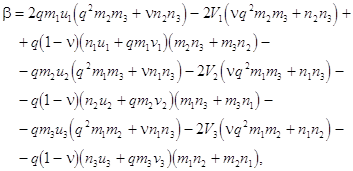
where ![]() .
.
Solutions to eqs.(11) describe four main types of
resonant triads in the cylindrical shell, namely ![]() -,
-,
![]() -,
-, ![]() - and
- and ![]() -type triads. Here
subscripts identify the type of modes, namely (
-type triads. Here
subscripts identify the type of modes, namely (![]() )
— longitudinal, (
)
— longitudinal, (![]() ) — bending, and
(
) — bending, and
(![]() ) — shear mode. The first
subscript stands for the primary unstable high-frequency mode, the other two
subscripts denote the secondary low-frequency modes.
) — shear mode. The first
subscript stands for the primary unstable high-frequency mode, the other two
subscripts denote the secondary low-frequency modes.
A new type of the nonlinear resonant wave coupling
appears in the cylindrical shell, namely ![]() -type
triads, unlike similar processes in bars, rings and plates. From the viewpoint
of mathematical modeling, it is obvious that the Karman-type equations cannot
describe the triple-wave coupling of
-type
triads, unlike similar processes in bars, rings and plates. From the viewpoint
of mathematical modeling, it is obvious that the Karman-type equations cannot
describe the triple-wave coupling of ![]() -,
-, ![]() - and
- and ![]() -types, but the
-types, but the ![]() -type triple-wave coupling
only. Since
-type triple-wave coupling
only. Since ![]() -type triads are inherent
in both the Karman and Donnell models, these are of interest in the present
study.
-type triads are inherent
in both the Karman and Donnell models, these are of interest in the present
study.
 -triads
-triads
High-frequency azimuthal waves in the shell can be
unstable with respect to small perturbations of low-frequency bending waves.
Figure (2) depicts a projection of the corresponding resonant manifold of the
shell possessing the spatial dimensions: ![]() and
and
![]() . The primary
high-frequency azimuthal mode is characterized by the spectral parameters
. The primary
high-frequency azimuthal mode is characterized by the spectral parameters ![]() and
and ![]() (the numerical values of
(the numerical values of ![]() and
and ![]() are given in the captions
to the figures). In the example presented the phase detuning
are given in the captions
to the figures). In the example presented the phase detuning ![]() does not exceed one
percent. Notice that the phase detuning almost always approaches zero at some
specially chosen ratios between
does not exceed one
percent. Notice that the phase detuning almost always approaches zero at some
specially chosen ratios between ![]() and
and ![]() , i.e. at some special
values of the parameter
, i.e. at some special
values of the parameter![]() . Almost all the
exceptions correspond, as a rule, to the long-wave processes, since in such
cases the parameter
. Almost all the
exceptions correspond, as a rule, to the long-wave processes, since in such
cases the parameter ![]() cannot be small,
e.g.
cannot be small,
e.g. ![]() .
.
NB Notice that ![]() -type
triads can be observed in a thin rectilinear bar, circular ring and in a flat
plate.
-type
triads can be observed in a thin rectilinear bar, circular ring and in a flat
plate.
NBThe wave modes entering ![]() -type triads can propagate
in the same spatial direction.
-type triads can propagate
in the same spatial direction.
 -triads
-triads
Analogously, high-frequency shear waves in the shell
can be unstable with respect to small perturbations of low-frequency bending
waves. Figure (3) displays the projection of the ![]() -type
resonant manifold of the shell with the same spatial sizes as in the previous
subsection. The wave parameters of primary high-frequency shear mode are
-type
resonant manifold of the shell with the same spatial sizes as in the previous
subsection. The wave parameters of primary high-frequency shear mode are ![]() and
and ![]() . The phase detuning does
not exceed one percent. The triple-wave resonant coupling cannot be observed in
the case of long-wave processes only, since in such cases the parameter
. The phase detuning does
not exceed one percent. The triple-wave resonant coupling cannot be observed in
the case of long-wave processes only, since in such cases the parameter ![]() cannot be small.
cannot be small.
NBThe wave modes entering ![]() -type triads cannot
propagate in the same spatial direction. Otherwise, the nonlinearity parameter
-type triads cannot
propagate in the same spatial direction. Otherwise, the nonlinearity parameter ![]() in eqs.(11) goes to zero,
as all the waves propagate in the same direction. This means that such triads
are essentially two-dimensional dynamical objects.
in eqs.(11) goes to zero,
as all the waves propagate in the same direction. This means that such triads
are essentially two-dimensional dynamical objects.
 -triads
-triads
High-frequency bending waves in the shell can be
unstable with respect to small perturbations of low-frequency bending and shear
waves. Figure (4) displays an example of projection of the ![]() -type resonant manifold of
the shell with the same sizes as in the previous sections. The spectral
parameters of the primary high-frequency bending mode are
-type resonant manifold of
the shell with the same sizes as in the previous sections. The spectral
parameters of the primary high-frequency bending mode are ![]() and
and ![]() . The phase detuning also
does not exceed one percent. The triple-wave resonant coupling can be observed
only in the case when the group velocity of the primary high-frequency bending
mode exceeds the typical velocity of shear waves.
. The phase detuning also
does not exceed one percent. The triple-wave resonant coupling can be observed
only in the case when the group velocity of the primary high-frequency bending
mode exceeds the typical velocity of shear waves.
NBEssentially, the spectral parameters of ![]() -type triads fall near the
boundary of the validity domain predicted by the Kirhhoff-Love theory. This
means that the real physical properties of
-type triads fall near the
boundary of the validity domain predicted by the Kirhhoff-Love theory. This
means that the real physical properties of ![]() -type
triads can be different than theoretical ones.
-type
triads can be different than theoretical ones.
NB![]() -type
triads are essentially two-dimensional dynamical objects, since the
nonlinearity parameter goes to zero, as all the waves propagate in the same
direction.
-type
triads are essentially two-dimensional dynamical objects, since the
nonlinearity parameter goes to zero, as all the waves propagate in the same
direction.
 -triads
-triads
High-frequency bending waves in the shell can be
unstable with respect to small perturbations of low-frequency bending waves.
Figure (5) displays an example of the projection of the ![]() -type resonant manifold of
the shell with the same sizes as in the previous sections. The wave parameters
of the primary high-frequency bending mode are
-type resonant manifold of
the shell with the same sizes as in the previous sections. The wave parameters
of the primary high-frequency bending mode are ![]() and
and
![]() . The phase detuning does
not exceed one percent. The triple-wave resonant coupling cannot also be
observed only in the case of long-wave processes, since in such cases the
parameter
. The phase detuning does
not exceed one percent. The triple-wave resonant coupling cannot also be
observed only in the case of long-wave processes, since in such cases the
parameter ![]() cannot be small.
cannot be small.
NBThe resonant interactions of ![]() -type are inherent in
cylindrical shells only.
-type are inherent in
cylindrical shells only.
Manly-Rawe relations
By multiplying each equation of the set (11) with the corresponding complex conjugate amplitude and then summing the result, one can reduce eqs.(11) to the following divergent laws
(12)
Notice that the equations of the set (12) are always
linearly dependent. Moreover, these do not depend upon the nonlinearity
potential ![]() . In the case of spatially
uniform wave processes (
. In the case of spatially
uniform wave processes (![]() )
eqs.(12) are reduced to the well-known Manly-Rawe algebraic relations
)
eqs.(12) are reduced to the well-known Manly-Rawe algebraic relations
(13)
where ![]() are
the portion of energy stored by the quasi-harmonic mode number
are
the portion of energy stored by the quasi-harmonic mode number ![]() ;
; ![]() are the integration
constants dependent only upon the initial conditions. The Manly-Rawe relations
(13) describe the laws of energy partition between the modes of the triad.
Equations (13), being linearly dependent, can be always reduced to the law of
energy conservation
are the integration
constants dependent only upon the initial conditions. The Manly-Rawe relations
(13) describe the laws of energy partition between the modes of the triad.
Equations (13), being linearly dependent, can be always reduced to the law of
energy conservation
(14)![]() .
.
Equation (14) predicts that the total energy of the
resonant triad is always a constant value ![]() ,
while the triad components can exchange by the portions of energy
,
while the triad components can exchange by the portions of energy ![]() , accordingly to the laws
(13). In turn, eqs.(13)-(14) represent the two independent first integrals to
the evolution equations (11) with spatially uniform initial conditions. These
first integrals describe an unstable hyperbolic orbit behavior of triads near
the stationary point
, accordingly to the laws
(13). In turn, eqs.(13)-(14) represent the two independent first integrals to
the evolution equations (11) with spatially uniform initial conditions. These
first integrals describe an unstable hyperbolic orbit behavior of triads near
the stationary point ![]() , or a stable
motion near the two stationary elliptic points
, or a stable
motion near the two stationary elliptic points ![]() ,
and
,
and ![]() .
.
In the case of spatially uniform dynamical processes
eqs.(11), with the help of the first integrals, are integrated in terms of
Jacobian elliptic functions [1,2]. In the particular case, as ![]() or
or ![]() , the general analytic
solutions to eqs.(11), within an appropriate Cauchy problem, can be obtained
using a technique of the inverse scattering transform [3]. In the general case
eqs.(11) cannot be integrated analytically.
, the general analytic
solutions to eqs.(11), within an appropriate Cauchy problem, can be obtained
using a technique of the inverse scattering transform [3]. In the general case
eqs.(11) cannot be integrated analytically.
Break-up instability of axisymmetric waves
Stability prediction of axisymmetric waves in cylindrical shells subject to small perturbations is of primary interest, since such waves are inherent in axisymmetric elastic structures. In the linear approximation the axisymmetric waves are of three types, namely bending, shear and longitudinal ones. These are the axisymmetric shear waves propagating without dispersion along the symmetry axis of the shell, i.e. modes polarized in the circumferential direction, and linearly coupled longitudinal and bending waves.
It was established experimentally and theoretically that axisymmetric waves lose the symmetry when propagating along the axis of the shell. From the theoretical viewpoint this phenomenon can be treated within several independent scenarios.
The simplest scenario of the dynamical instability
is associated with the triple-wave resonant coupling, when the high-frequency
mode breaks up into some pairs of secondary waves. For instance, let us suppose
that an axisymmetric quasi-harmonic longitudinal wave (![]() and
and ![]() ) travels along the shell.
Figure (6) represents a projection of the triple-wave resonant manifold of the
shell, with the geometrical sizes
) travels along the shell.
Figure (6) represents a projection of the triple-wave resonant manifold of the
shell, with the geometrical sizes ![]() m;
m; ![]() m;
m; ![]() m, on the plane of wave
numbers. One can see the appearance of six secondary wave pairs nonlinearly
coupled with the primary wave. Moreover, in the particular case the triple-wave
phase matching is reduced to the so-called resonance 2:1. This one can be
proposed as the main instability mechanism explaining some experimentally
observed patterns in shells subject to periodic cinematic excitations [4].
m, on the plane of wave
numbers. One can see the appearance of six secondary wave pairs nonlinearly
coupled with the primary wave. Moreover, in the particular case the triple-wave
phase matching is reduced to the so-called resonance 2:1. This one can be
proposed as the main instability mechanism explaining some experimentally
observed patterns in shells subject to periodic cinematic excitations [4].
It was pointed out in the paper [5] that the
resonance 2:1 is a rarely observed in shells. The so-called resonance 1:1 was
proposed instead as the instability mechanism. This means that the primary
axisymmetric mode (with ![]() ) can be
unstable one with respect to small perturbations of the asymmetric mode (with
) can be
unstable one with respect to small perturbations of the asymmetric mode (with ![]() ) possessing a natural
frequency closed to that of the primary one. From the viewpoint of theory of
waves this situation is treated as the degenerated four-wave resonant
interaction.
) possessing a natural
frequency closed to that of the primary one. From the viewpoint of theory of
waves this situation is treated as the degenerated four-wave resonant
interaction.
In turn, one more mechanism explaining the loss of stability of axisymmetric waves in shells based on a paradigm of the so-called nonresonant interactions can be proposed [6,7,8]. By the way, it was underlined in the paper [6] that theoretical prognoses relevant to the modulation instability are extremely sensible upon the model explored. This means that the Karman-type equations and Donnell-type equations lead to different predictions related the stability properties of axisymmetric waves.
Self-action
The propagation of any intense bending waves in a long cylindrical shell is accompanied by the excitation of long-wave displacements related to the in-plane tensions and rotations. In turn, these long-wave fields can influence on the theoretically predicted dependence between the amplitude and frequency of the intense bending wave.
Moreover, quasi-harmonic bending waves, whose group velocities do not exceed the typical propagation velocity of shear waves, are stable against small perturbations within the lowest-order nonlinear approximation analysis. However amplitude envelopes of these waves can be unstable with respect to small long-wave perturbations in the next approximation.
Amplitude-frequency curve
Let us consider a stationary wave
![]()
traveling along the single direction characterized
by the ''companion'' coordinate ![]() . By
substituting this expression into the first and second equations of the set
(1)-(2), one obtains the following differential relations
. By
substituting this expression into the first and second equations of the set
(1)-(2), one obtains the following differential relations
(15)
Here
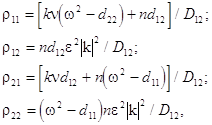
while

where![]() and
and ![]() .
.
Using (15) one can get the following nonlinear ordinary differential equation of the fourth order:
(16)![]() ,
,
which describes simple stationary waves in the cylindrical shell (primes denote differentiation). Here

where![]() and
and ![]() are the integration
constants.
are the integration
constants.
If the small parameter ![]() ,
and
,
and ![]() ,
, ![]() ,
, ![]() satisfies the dispersion
relation (4), then a periodic solution to the linearized equation (16) reads
satisfies the dispersion
relation (4), then a periodic solution to the linearized equation (16) reads
![]()
where ![]() are
arbitrary constants, since
are
arbitrary constants, since ![]() .
.
Let the parameter ![]() be
small enough, then a solution to eq.(16) can be represented in the following
form
be
small enough, then a solution to eq.(16) can be represented in the following
form
(17)![]()
where the amplitude ![]() depends
upon the slow variables
depends
upon the slow variables ![]() , while
, while ![]() are small nonresonant
corrections. After the substitution (17) into eq.( 16) one obtains the
expression of the first-order nonresonant correction
are small nonresonant
corrections. After the substitution (17) into eq.( 16) one obtains the
expression of the first-order nonresonant correction
![]()
and the following modulation equation
(18)![]() ,
,
where the nonlinearity coefficient is given by
 .
.
Suppose that the wave vector ![]() is conserved in the
nonlinear solution. Taking into account that the following relation
is conserved in the
nonlinear solution. Taking into account that the following relation
![]()
holds true for the stationary waves, one gets the following modulation equation instead of eq.(18):
![]()
or
![]() ,
,
where the point denotes differentiation on the slow
temporal scale ![]() . This equation
has a simple solution for spatially uniform and time-periodic waves of constant
amplitude
. This equation
has a simple solution for spatially uniform and time-periodic waves of constant
amplitude ![]() :
:
 ,
,
which characterizes the amplitude-frequency response curve of the shell or the Stocks addition to the natural frequency of linear oscillations:
(19) .
.
Spatio-temporal modulation of waves
Relation (19) cannot provide information related to the modulation instability of quasi-harmonic waves. To obtain this, one should slightly modify the ansatz (17):
(20)
where ![]() and
and ![]() denote the long-wave
slowly varying fields being the functions of arguments
denote the long-wave
slowly varying fields being the functions of arguments ![]() and
and ![]() (these turn in constants
in the linear theory);
(these turn in constants
in the linear theory); ![]() is the amplitude
of the bending wave;
is the amplitude
of the bending wave; ![]() ,
, ![]() and
and ![]() are small nonresonant
corrections. By substituting the expression (20) into the governing equations
(1)-(2), one obtains, after some rearranging, the following modulation
equations
are small nonresonant
corrections. By substituting the expression (20) into the governing equations
(1)-(2), one obtains, after some rearranging, the following modulation
equations
(21)
where ![]() is the
group velocity, and
is the
group velocity, and ![]() . Notice that
eqs.(21) have a form of Zakharov-type equations.
. Notice that
eqs.(21) have a form of Zakharov-type equations.
Consider the stationary quasi-harmonic bending wave
packets. Let the propagation velocity be ![]() ,
then eqs.(21) can be reduced to the nonlinear Schrцdinger equation
,
then eqs.(21) can be reduced to the nonlinear Schrцdinger equation
(22)![]() ,
,
where the nonlinearity coefficient is equal to
 ,
,
while the non-oscillatory in-plane wave fields are defined by the following relations
![]()
and
 .
.
The theory of modulated waves predicts that the amplitude envelope of a wavetrain governed by eq.(22) will be unstable one provided the following Lighthill criterion
(23)![]()
is satisfied.
Envelope solitons
The experiments described in the paper [7] arise
from an effort to uncover wave systems in solids which exhibit soliton
behavior. The thin open-ended nickel cylindrical shell, having the dimensions ![]() cm,
cm, ![]() cm and
cm and ![]() cm, was made by an
electroplating process. An acoustic beam generated by a horn driver was aimed
at the shell. The elastic waves generated were flexural waves which propagated
in the axial,
cm, was made by an
electroplating process. An acoustic beam generated by a horn driver was aimed
at the shell. The elastic waves generated were flexural waves which propagated
in the axial, ![]() , and
circumferential,
, and
circumferential, ![]() , direction. Let
, direction. Let ![]() and
and ![]() , respectively, be the
eigen numbers of the mode. The modes in which
, respectively, be the
eigen numbers of the mode. The modes in which ![]() is
always one and
is
always one and ![]() ranges from 6 to
32 were investigated. The only modes which we failed to excite (for unknown
reasons) were
ranges from 6 to
32 were investigated. The only modes which we failed to excite (for unknown
reasons) were ![]() = 9,10,19. A
flexural wave pulse was generated by blasting the shell with an acoustic wave
train typically 15 waves long. At any given frequency the displacement would be
given by a standing wave component and a traveling wave component. If the
pickup transducer is placed at a node in the standing wave its response will be
limited to the traveling wave whose amplitude is constant as it propagates.
= 9,10,19. A
flexural wave pulse was generated by blasting the shell with an acoustic wave
train typically 15 waves long. At any given frequency the displacement would be
given by a standing wave component and a traveling wave component. If the
pickup transducer is placed at a node in the standing wave its response will be
limited to the traveling wave whose amplitude is constant as it propagates.
The wave pulse at frequency of 1120 Hz was generated. The measured speed of the clockwise pulse was 23 m/s and that of the counter-clockwise pulse was 26 m/s, which are consistent with the value calculated from the dispersion curve (6) within ten percents. The experimentally observed bending wavetrains were best fitting plots of the theoretical hyperbolic functions, which characterizes the envelope solitons. The drop in amplitude, in 105/69 times, was believed due to attenuation of the wave. The shape was independent of the initial shape of the input pulse envelope.
The agreement between the experimental data and the
theoretical curve is excellent. Figure 7 displays the dependence of the
nonlinearity coefficient ![]() and
eigen frequencies
and
eigen frequencies ![]() versus the wave
number
versus the wave
number ![]() of the cylindrical shell
with the same geometrical dimensions as in the work [7]. Evidently, the
envelope solitons in the shell should arise accordingly to the Lighthill
criterion (23) in the range of wave numbers
of the cylindrical shell
with the same geometrical dimensions as in the work [7]. Evidently, the
envelope solitons in the shell should arise accordingly to the Lighthill
criterion (23) in the range of wave numbers ![]() =6,7,..,32,
as
=6,7,..,32,
as ![]() .
.
REFERENCES
[1]Bretherton FP (1964), Resonant interactions between waves, J. Fluid Mech., 20, 457-472.
[2]Bloembergen K. (1965), Nonlinear optics, New York-Amsterdam.
[3]Ablowitz MJ, H Segur (1981), Solitons and the Inverse Scattering Transform, SIAM, Philadelphia.
[4]Kubenko VD, Kovalchuk PS, Krasnopolskaya TS (1984), Nonlinear interaction of flexible modes of oscillation in cylindrical shells, Kiev: Naukova dumka publisher (in Russian).
[5]Ginsberg JM (1974), Dynamic stability of transverse waves in circular cylindrical shell, Trans. ASME J. Appl. Mech., 41(1), 77-82.
[6]Bagdoev AG, Movsisyan LA (1980), Equations of modulation in nonlinear dispersive media and their application to waves in thin bodies, .Izv. AN Arm.SSR, 3, 29-40 (in Russian).
[7]Kovriguine DA, Potapov AI (1998), Nonlinear oscillations in a thin ring - I(II), Acta Mechanica, 126, 189-212.